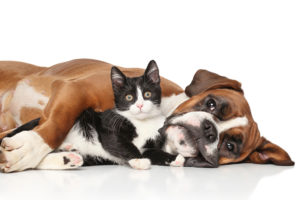Giving Your Pet Pills

Medicines are intended to enhance and protect the health of our pets but giving oral medication to companion animals can be a trying process. Have no fear pet caregivers, there are proven techniques that will make pilling your pet a more pleasant experience for everyone involved.
“Choking and poisoning should be the first line of protection for pets taking medication, and your veterinarian’s instructions should be followed to the letter,” states Ms. Patty Hug, Veterinary Technician III, Veterinary Teaching Hospital, College of Veterinary Medicine & Biomedical Sciences, Texas A&M University. “Pet caregivers should take precaution to avoid pet choking by administering pills when the pet is in a sternal or standing position, never while lying down.” Also, Hug suggests that if in doubt, write the medication instructions down prior to leaving your veterinarian’s office, this will help prevent over medicating.
Pills may be given by hand, but a safer technique utilizes a “Pet Piller”. This instrument is made of durable, washable hard plastic that has a rubber tip on which the pill is placed. “Ever so gently place the pill end of the piller at the side of the mouth; the pet may open its mouth, then the piller can be placed at the back of the tongue, and the pill dispensed by ‘injecting’ it into the pet’s mouth.” Hug says that it is important not to gag the patient with the piller. Also, close the pet’s mouth and hold it’s snout until there is evidence that the pill has been swallowed. Gently stroking the pet’s throat or blowing on its nose generally makes the pet swallow the pill more quickly. Additionally, be sure to offer your pet a drink of water for the pill to fully go down the esophagus; this is especially true for cats.
Hug suggests another method to administer pet medication that involves ‘hiding’ your pet’s medication. “Some pets need to have oral medicine hidden in a piece of bread, extremely low fat cream cheese, squeeze cheese (sharp cheddar is most popular), or canned food.” Hiding oral medicine in a food item entices your pet to eat the ‘treat’ while diminishing the smell and taste of the medicine before it is swallowed. Hug also recommends a popular pill-taking enhancer called ‘pill pockets’. These are specifically formed for various pill sizes and are flavored to appeal to the most finicky medication-evading pet, notes Hug. Pill pocket flavors include beef, salmon, and chicken; they can be obtained at your veterinarian’s office.
“Oral medication should not be given if the pet vomits, or shows any type of stress; never proceed thinking that the pet is just being difficult,” notes Hug. Pets let us know when something is not right, so consult your veterinarian if you are not able to pill your pet due to adverse circumstances.
Follow your veterinarian’s oral instructions and the instructions as they are indicated on the medicine bottle. Some medications are labeled with a sticker that states “Give with Food” and this instruction should be followed so that your pet does not get an upset stomach while taking the medication.
“Never self-medicate pets with human medications,” advises Hug. Only your veterinarian is qualified and knowledgeable to recommend or prescribe ‘human’ medications for your pet. Your veterinarian knows how the medicine will affect your pet in its current physiological state.
Hug says, “Crushing pills is only reserved for the veterinarian or the pharmacist to compound the medication into a substance that will support a ‘crushed’ pill. If your veterinarian did not state to crush the medicine, then don’t. Many medications work in different ways, and disrupting the actual pill may cause the medication to be of no benefit or, diminish the effectiveness of the medication.” Hug notes that capsules and pills in foil packets should never be crushed.
Your pet’s health and well being may be dependent on medicines prescribed by your veterinarian but your pet depends on you to administer the medication. Learning pet pilling techniques will keep you safe and also protect the health of your pet. And remember, once your pet does take its oral medicine (and a gulp of water), offer it a pat on the head for comforting reassurance that all is well.
Pet Talk is a service of the College of Veterinary Medicine & Biomedical Sciences, Texas A&M University. Stories can be viewed on the Web at vetmed.tamu.edu/news/pet-talk. Suggestions for future topics may be directed to editor@cvm.tamu.edu.
Angela G. Clendenin
Director, Communications & Public Relations
Ofc – (979) 862-2675
Cell – (979) 739-5718


